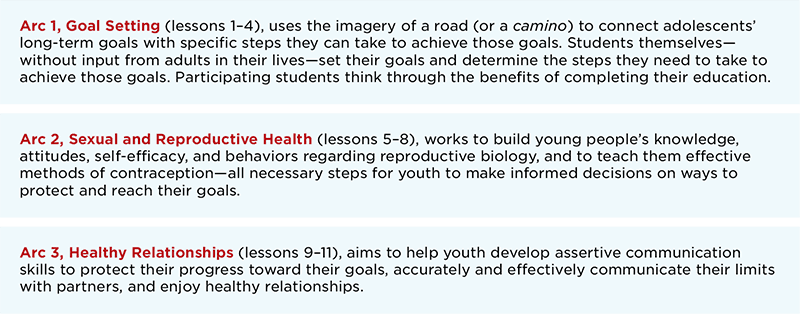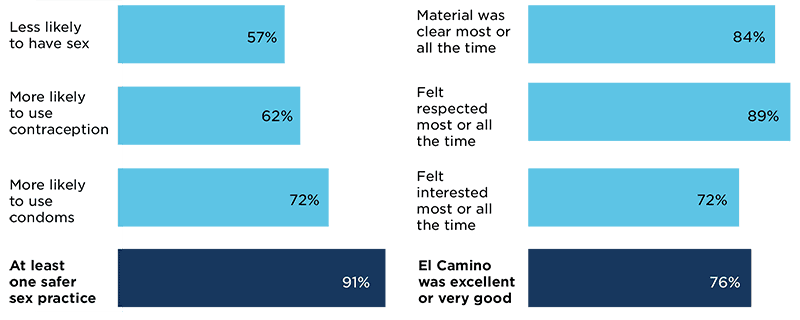El Camino: Helping Teens Set Life Goals and Promote Sexual Health
El Camino is a research-based goal-setting sexual health promotion program developed by Child Trends based on the principles of Positive Youth Development. El Camino promotes adolescent sexual health by encouraging youth to set goals, make informed sexual and reproductive health choices that align with those goals, and learn to communicate their sexual health limits. The program helps teens develop their own camino, or road, to pursue goals they identify for themselves.
This fact sheet describes the El Camino curriculum and preliminary results from a pilot test of the program in seven schools and community-based organizations across six cities. El Camino serves high school-aged, English- or Spanish-speaking Latino adolescents who are male, female, or nonbinary—as well as other adolescents from historically excluded neighborhoods in the United States—and has been implemented with a wide range of students ages 13 to 20.
About the El Camino Curriculum
The El Camino curriculum is developmentally appropriate, active, engaging, and youth-focused. It incorporates several unique features that distinguish it from other evidence-based/evidence-informed curricula designed to prevent teen pregnancy and STIs. In particular, El Camino’s lessons and activities:
- Are anchored in sexual health promotion and goal setting
- Incorporate a goal achievement model throughout the curriculum
- Are designed with a focus on the needs of Latino youth
- Focus on the most effective forms of contraception, including long-acting reversible contraceptives (LARCs)
The El Camino curriculum contains eleven 45-minute lessons and is divided into three sections, or arcs. The three arcs focus on goal setting, sexual and reproductive health, and healthy relationships. Each lesson is briefly summarized in the table at the end of this fact sheet.

El Camino Activities
El Camino incorporates a variety of activities to engage students. These activities are not designed to tell students what to do or think; instead, they encourage students to think for themselves about important issues like relationships, school, and their futures. In El Camino, students engage in activities that include:![]()
- Reading stories/novelas throughout the curriculum that feature teen characters with whom they share key characteristics
- “Voting with your feet,” meaning physically moving around a room to show agreement or disagreement with a statement or idea
- Role-playing with other students using scenarios about similar teenagers
- Participating in group discussions with teachers to discuss their thoughts and get answers to their questions
- Goal mapping—writing their personal goal, to achieve by age 25, on a map and thinking about the steps necessary to reach that goal
- Practicing skills by implementing concepts learned (for example, practicing assertive communication with partners or proper condom use)
Pilot Data and Findings
From 2015 to 2018, Child Trends developed and tested El Camino with more than 300 students in Washington, DC; East Chicago, IN; Tacoma, WA; Baltimore, MD; Los Angeles, CA; and Philadelphia, PA. We worked with partner schools and organizations to implement El Camino with racially diverse groups of students in both English and Spanish; during and after school; and with classroom teachers, AmeriCorps volunteers, and Communities in Schools staff.[1] After each implementation, we revised the curriculum based on classroom observations, fidelity data, and debriefs with students and facilitators.

Preliminary outcomes[3]
Child Trends surveyed students before and after their participation in El Camino. At the post-test survey, we asked students whether they thought El Camino had made them more or less likely to have sex and whether, if they were to have sex, the program had made them more or less likely to use contraception or a condom. Results were very encouraging, with the vast majority of students (91%) reporting that El Camino had made them either less likely to have sex, more likely to use contraception, or more likely to use a condom. Students reported high satisfaction with the program, and about three quarters said it was “excellent” or “very good.”

From pre-test to post-test, students who participated in El Camino also reported significant changes in important attitudes and knowledge.[4]
- Confidence about discussing sex and consent. Students reported feeling more confident in talking about sex and consent with their partners at the end of the program.
- Contraceptive knowledge. When given three questions about contraceptives, at the beginning and end of the program, students improved from getting 49 percent correct, on average, to getting 74 percent correct—a 25 percentage-point increase.[5]
- Setting goals. Before El Camino, 64 percent of students agreed they had goals to accomplish before having a child. This increased to 80 percent of students at the end of El Camino.
For more information please contact elcamino@childtrends.org
El Camino is available online on the Child Trends website. Materials are available at no cost here: https://childtrends.org/publications/el-camino-a-goal-setting-sexual-health-promotion-program
We would like to thank The JPB Foundation for their generous support in funding the curriculum development and field testing. Child Trends is conducting a multi-year evaluation (2020-2023) of El Camino in Montgomery County, MD, in partnership with Identity, Inc., and the University of Maryland with funding from the Office of Population Affairs, DHHS.
Endnotes
[1] Moore, J.A., Manlove, J., Faccio, B., Parekh, J., & Beckwith, S. (2018). El Camino, a goal-setting teen pregnancy program, finds promising results (blog). Bethesda, MD: Child Trends.
[2] Based on survey data from 136 students.
[3] Based on post-test survey data from 94 students. Number of surveys varies by outcome.
[4] Based on a sample of 55 matched student surveys.
[5] Questions ask about the effectiveness of the IUD relative to the condom, the effectiveness of the implant relative to the birth control pill, and about whether the IUD causes infertility.
© Copyright 2024 ChildTrendsPrivacy Statement
Newsletter SignupLinkedInThreadsYouTube